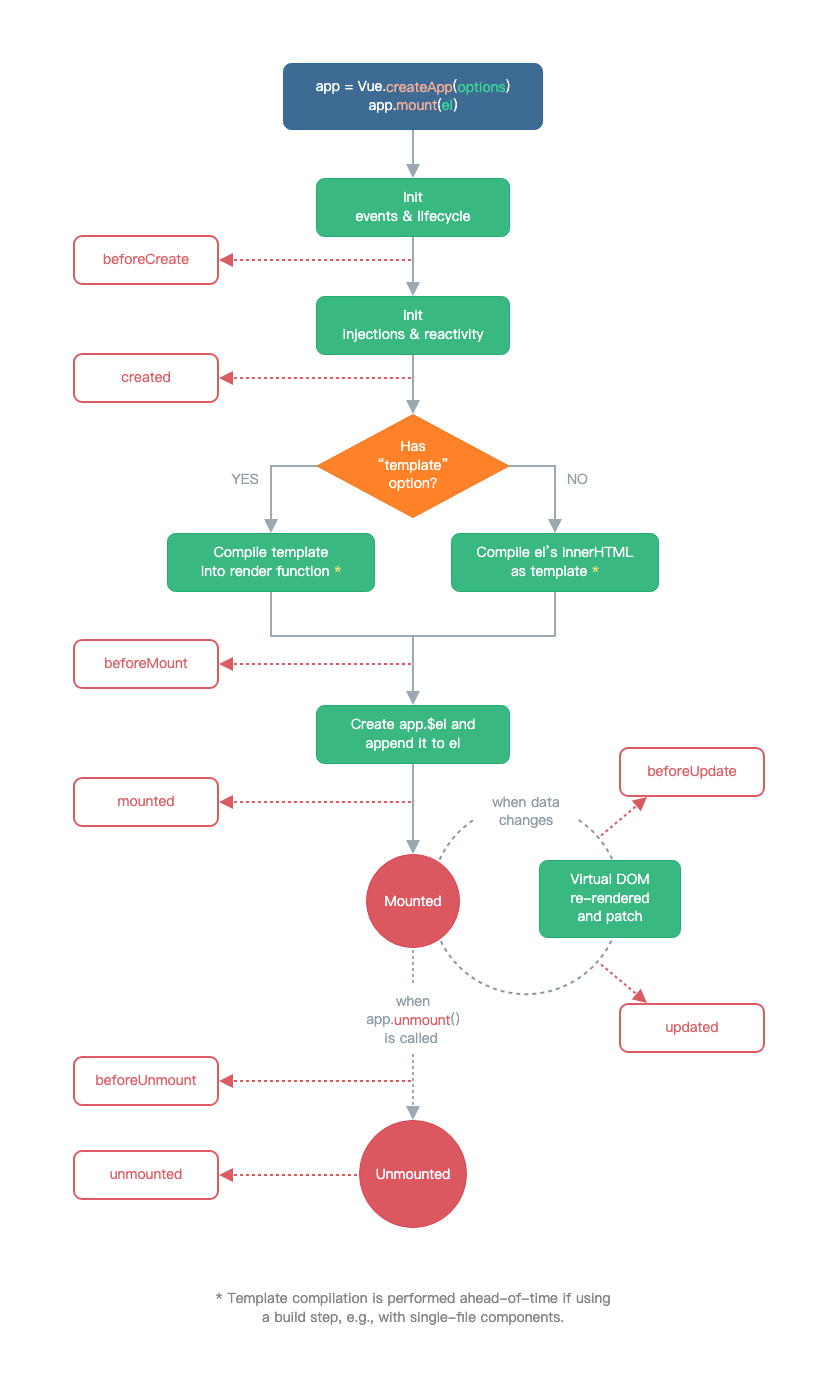VUE3.0和VUE2.0语法上的不同
前言:本篇文章只做VUE3.0和VUE2.0语法上的不同分析,不做性能和源码架构等的分析。
一、VUE3.0和VUE2.0代码结构不同
- VUE3.0代码实例🌰
<template>
<div>
<span>count is {{ count }}</span>
<span>plusOne is {{ plusOne }}</span>
<button @click="increment">count++</button>
</div>
</template>
<script>
import { value, computed, watch, onMounted, ref } from 'vue'
export default {
setup() {
// ref state
const count = ref(0)
// computed state
const plusOne = computed(() => count.value + 1)
// method
const increment = () => { count.value++ }
// watch
watch(() => count.value * 2, val => {
console.log(`count * 2 is ${val}`)
})
// lifecycle
onMounted(() => {
console.log(`mounted`)
})
// expose bindings on render context
return {
count,
plusOne,
increment
}
}
}
</script>
也可以不用写setup函数,可以直接把setup写到script标签上
- VUE3.0代码实例🌰
<template>
<div>
<span>count is {{ count }}</span>
<span>plusOne is {{ plusOne }}</span>
<button @click="increment">count++</button>
</div>
</template>
<script setup lang="ts">
import { computed, watch, onMounted, ref } from 'vue'
// ref state
const count = ref(0)
// computed state
const plusOne = computed(() => count.value + 1)
// method
const increment = () => { count.value++ }
// watch
watch(() => count.value * 2, val => {
console.log(`count * 2 is ${val}`)
})
// lifecycle
onMounted(() => {
console.log(`mounted`)
})
</script>
- 相应的VUE2.0代码实例🌰
<template>
<div>
<span>count is {{ count }}</span>
<span>plusOne is {{ plusOne }}</span>
<button @click="increment">count++</button>
</div>
</template>
<script>
export default {
data() {
return {
count: 0
};
},
methods: {
increment: function () {
this.count++;
}
},
computed: {
plusOne: function () {
return this.count + 1;
}
},
watch: {
count: function (val) {
console.log(`count * 2 is ${val * 2}`)
}
},
mounted() {
console.log(`mounted`);
}
};
</script>
VUE2.0和VUE3.0的代码对比一下:
VUE2.0是将mounted、data、computed、watch之类的方法作为VUE对象的属性进行导出。
VUE3.0新增了一个名为setup的入口函数,value, computed, watch, onMounted等方法都需要从外部import。
evernotecid://CA5E4AF5-56FE-42CC-9E43-67CF1FF3C17E/appyinxiangcom/27675019/ENResource/p130

二、关于VUE3.0和VUE2.0生命周期
- VUE2.0生命周期
1、beforeCreate:在实例初始化之后、进行数据侦听和事件/侦听器的配置之前同步调用
2、created:在实例创建完成后被立即同步调用。在这一步中,实例已完成对选项的处理,意味着以下内容已被配置完毕:数据侦听、计算属性、方法、事件/侦听器的回调函数。然而,挂载阶段还没开始,且 $el property 目前尚不可用。
3、beforeMount:在挂载开始之前被调用:相关的 render 函数首次被调用。
4、mounted:在实例挂载完成后被调用。
5、beforeUpdate:在数据发生改变后,DOM 被更新之前被调用。这里适合在现有 DOM 将要被更新之前访问它,比如移除手动添加的事件监听器。
6、updated:在数据更改导致的虚拟 DOM 重新渲染和更新完毕之后被调用。
7、activated:被 keep-alive 缓存的组件激活时调用。
8、deactivated:被 keep-alive 缓存的组件失活时调用。
9、beforeUnmount:在卸载组件实例之前调用。在这个阶段,实例仍然是完全正常的。
10、unmounted:卸载组件实例后调用。调用此钩子时,组件实例的所有指令都被解除绑定,所有事件侦听器都被移除,所有子组件实例被卸载。

- VUE3.0生命周期
1、setup: 同VUE2.0的beforeCreate和created。
2、onBeforeMount:同VUE2.0的beforeMount。
3、onMounted:同VUE2.0的mounted。
4、onBeforeUpdate:同VUE2.0的beforeMount。
5、onUpdated:同VUE2.0的updated。
6、onBeforeUnmount:同VUE2.0的beforeUnmount。
7、onUnmounted:同VUE2.0的unmounted。
8、onMounted:同VUE2.0的beforeMount。
9、onActivated:同VUE2.0的activated。
10、onDeactivated:同VUE2.0的deactivated。
evernotecid://CA5E4AF5-56FE-42CC-9E43-67CF1FF3C17E/appyinxiangcom/27675019/ENResource/p132

VUE3.0和VUE2.0响应式
- VUE3.0响应数据
1、ref():让简单类型的数据变成响应式数据。这种数据是Number或者String等基本类型数据,这种数据是通过值而非引用传递的类型。
import { ref } from 'vue'
const count = ref(0)
console.log(count.value) // 0
count.value++
console.log(count.value) // 1
2、reactive(): 让复杂类型数据变成响应式,不需要.value包裹。
import { reactive } from 'vue'
// 响应式状态
const state = reactive({
count: 0
})
state.count.value++
console.log(state.count) // 1
注意:当ref作为响应式对象的值被更改时,ref的内部值也会发生改变。
const count = ref(0)
const state = reactive({
count
})
console.log(state.count) // 0
state.count = 1
console.log(count.value) // 1
注意:使用ES6解构响应式对象时,响应式会丢失。
import { reactive } from 'vue'
const book = reactive({
author: 'Vue Team',
year: '2020',
title: 'Vue 3 Guide',
description: 'You are reading this book right now ;)',
price: 'free'
})
let { author, title } = book
对于这种情况,我们需要将我们的响应式对象转换为一组 ref。这些 ref 将保留与源对象的响应式关联,使用toRefs():
import { reactive, toRefs } from 'vue'
const book = reactive({
author: 'Vue Team',
year: '2020',
title: 'Vue 3 Guide',
description: 'You are reading this book right now ;)',
price: 'free'
})
let { author, title } = toRefs(book)
title.value = 'Vue 3 Detailed Guide' // 我们需要使用 .value 作为标题,现在是 ref
console.log(book.title) // 'Vue 3 Detailed Guide'
watch监听属性
- VUE3.0 watch监听
import { ref, watch } from 'vue'
const counter = ref(0)
watch(counter, (newValue, oldValue) => {
console.log('The new counter value is: ' + counter.value)
})
- VUE2.0 watch监听
export default {
data() {
return {
counter: 0
}
},
watch: {
counter(newValue, oldValue) {
console.log('The new counter value is: ' + this.counter)
}
}
}
computed计算属性
- VUE3.0 computed计算
import { ref, computed } from 'vue'
const counter = ref(0)
const twiceTheCounter = computed(() => counter.value * 2)
counter.value++
console.log(counter.value) // 1
console.log(twiceTheCounter.value) // 2
- VUE2.0 computed计算
Vue.createApp({
data() {
return {
counter: 0
}
},
computed: {
twiceTheCounter() {
return counter * 2
}
}
}).mount('#demo')
父子组件通过props传递值
- VUE3.0 props
// MyBook.vue
export default {
props: {
title: String
},
setup(props) {
console.log(props.title)
}
}
或者
<script setup>
const props = defineProps({
title: {
type: String
}
})
</script>
- VUE2.0 props
export default {
name: 'Demo',
props: {
count: {
type: Number,
default: 1
},
arrValue: {
type: Array,
default () {
return []
}
}
},
mounted() {
console.log(this.count)
}
}
emit子组件向父组件抛出事件
- VUE2.0
VUE2.0可以通过this.$emit()向父组件抛出事件
- VUE3.0
setup(props, { emit }) {
const close = ()=>{
emit("change")
}
return{
close
}
}
或者
<script setup>
const emit = defineEmits(["change"])
const close = ()=>{
emit("change")
}
</script>
$refs
- VUE2.0
vue2.0可以直接通过this.$refs.访问子组件
- VUE3.0
<template>
<div ref="refDemo" />
</template>
<script setup>
const refDemo = ref()
console.log(refDemo.value)
</script>
注意:1、通过变量的命名要和ref相同。
2、通过ref来访问子组件的方法,子组件要通过expose将事件和变量暴露出来,这样父组件才能访问到
VUE3.0 context
- VUE2.0
VUE2.0可以通过this来访问VUE实例上的方法和变量。例如this. e m i t 、 t h i s . emit、this. emit、this.refs、this.$slots.
- VUE3.0
context 是一个普通 JavaScript 对象,暴露了其它可能在 setup 中有用的值:
export default {
setup(props, context) {
// Attribute (非响应式对象,等同于 $attrs)
console.log(context.attrs)
// 插槽 (非响应式对象,等同于 $slots)
console.log(context.slots)
// 触发事件 (方法,等同于 $emit)
console.log(context.emit)
// 暴露公共 property (函数)
console.log(context.expose)
}
}
**注意:在setup时,你只能访问props、attrs、slots、emit。无法访问data、computed、methods、refs (模板 ref)
更多细节可看VUE官方文档:https://v3.cn.vuejs.org/guide/composition-api-setup.html